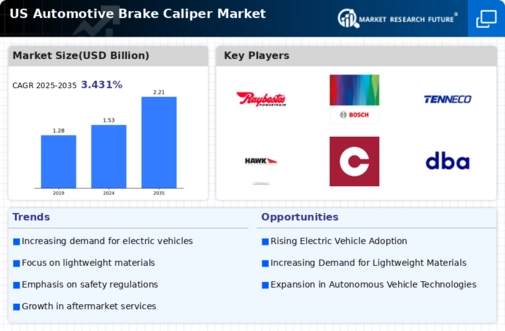Increasing Vehicle Production
The automotive brake-caliper market is experiencing growth due to the rising production of vehicles in the US. As manufacturers ramp up output to meet consumer demand, the need for reliable braking systems becomes paramount. In 2025, vehicle production is projected to reach approximately 12 million units, which directly correlates with the demand for brake components. This surge in production not only boosts the automotive brake-caliper market but also encourages manufacturers to innovate and enhance their product offerings. The competition among automakers to provide safer and more efficient vehicles further drives the demand for advanced brake-caliper technologies. Consequently, the automotive brake-caliper market is likely to benefit from this upward trend in vehicle production, as more vehicles on the road necessitate high-quality braking systems.
Growth of Aftermarket Services
The automotive brake-caliper market is also experiencing growth due to the expansion of aftermarket services in the US. As vehicle ownership increases, so does the need for maintenance and replacement of brake components. The aftermarket segment is projected to grow at a rate of 5% annually, driven by consumers seeking high-quality replacement parts. This trend presents opportunities for manufacturers to develop and market brake-calipers specifically designed for the aftermarket. Additionally, the rise of online retail platforms has made it easier for consumers to access a wide range of brake components, further fueling demand. The automotive brake-caliper market is likely to benefit from this trend as more vehicle owners prioritize the maintenance of their braking systems.
Rising Demand for Performance Vehicles
The automotive brake-caliper market is benefiting from the increasing consumer preference for performance vehicles in the US. As more drivers seek enhanced driving experiences, the demand for high-performance braking systems has surged. Performance vehicles often require specialized brake-calipers that can withstand higher temperatures and provide superior stopping power. This trend is reflected in the market, where the performance segment is expected to grow by approximately 8% annually through 2025. Manufacturers are responding by developing advanced materials and designs that cater to this niche market, thereby expanding their product lines. The automotive brake-caliper market is likely to see continued growth as performance vehicles become more popular among consumers.
Regulatory Compliance and Safety Standards
The automotive brake-caliper market is significantly influenced by stringent regulatory compliance and safety standards imposed by US authorities. These regulations mandate that vehicles meet specific safety criteria, which includes the performance of braking systems. As a result, manufacturers are compelled to invest in high-quality brake-caliper designs that adhere to these standards. The National Highway Traffic Safety Administration (NHTSA) has established guidelines that require regular testing and certification of brake components. This regulatory environment not only ensures consumer safety but also drives innovation within the automotive brake-caliper market. Companies that prioritize compliance are likely to gain a competitive edge, as consumers increasingly seek vehicles that meet or exceed safety expectations.
Technological Advancements in Brake Systems
The automotive brake-caliper market is expected to grow due to ongoing technological advancements in braking systems. Innovations such as electronic brake-force distribution and anti-lock braking systems are becoming standard in modern vehicles. These technologies enhance vehicle safety and performance, leading to increased demand for advanced brake-calipers. In 2025, it is estimated that over 60% of new vehicles will be equipped with some form of advanced braking technology, which directly impacts the automotive brake-caliper market. Manufacturers are investing in research and development to create brake-calipers that integrate seamlessly with these technologies, ensuring optimal performance. This trend indicates a shift towards more sophisticated braking solutions, which could redefine market dynamics.



















Leave a Comment